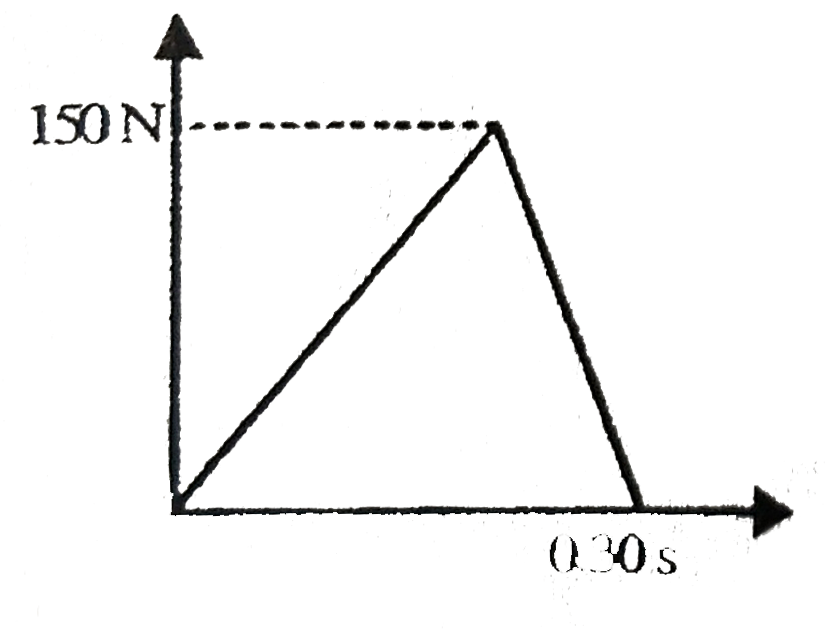The solid rubber balls A and B having masses 200 and 400 gm respectively are moving in opposite directions with velocity of A equal to 0.3 m / s . After collision the two balls come to rest, then the velocity of B is
0.15ms−1
−0.15ms−1
1.5ms−1
3.0ms−1
The correct Answer is:B
To solve the problem, we will use the principle of conservation of momentum. Let's break it down step by step.
1. Identify the Given Data:
- Mass of ball A, mA=200g=0.2kg
- Mass of ball B, mB=400g=0.4kg
- Velocity of ball A, vA=0.3m/s
- Velocity of ball B, vB=? (to be determined)
2. Understand the Direction of Motion:
- Since the balls are moving in opposite directions, we can assign a negative sign to the velocity of ball B. Thus, we can denote vB=−u where u is the magnitude of the velocity of ball B.
3. Apply the Conservation of Momentum:
- According to the conservation of momentum:
Initial Momentum=Final Momentum
- Before the collision:
Initial Momentum=mA⋅vA+mB⋅vB
- After the collision, both balls come to rest, so:
Final Momentum=0
4. Set Up the Equation:
mA⋅vA+mB⋅(−u)=0
Substituting the values:
0.2⋅0.3+0.4⋅(−u)=0
5. Solve for u:
0.06−0.4u=0
Rearranging gives:
0.4u=0.06
u=0.060.4=0.15m/s
6. Determine the Velocity of Ball B:
Since we assigned a negative sign to vB:
vB=−u=−0.15m/s
Final Answer:
The velocity of ball B is −0.15m/s. The negative sign indicates that it is moving in the opposite direction to ball A.
- Mass of ball A, mA=200g=0.2kg
- Mass of ball B, mB=400g=0.4kg
- Velocity of ball A, vA=0.3m/s
- Velocity of ball B, vB=? (to be determined)
- Since the balls are moving in opposite directions, we can assign a negative sign to the velocity of ball B. Thus, we can denote vB=−u where u is the magnitude of the velocity of ball B.
- According to the conservation of momentum:
Initial Momentum=Final Momentum
- Before the collision:
Initial Momentum=mA⋅vA+mB⋅vB
- After the collision, both balls come to rest, so:
Final Momentum=0
mA⋅vA+mB⋅(−u)=0
Substituting the values:
0.2⋅0.3+0.4⋅(−u)=0
0.06−0.4u=0
Rearranging gives:
0.4u=0.06
u=0.060.4=0.15m/s
Since we assigned a negative sign to vB:
vB=−u=−0.15m/s
The velocity of ball B is −0.15m/s. The negative sign indicates that it is moving in the opposite direction to ball A.
Topper's Solved these Questions
- WORK ENERGY AND POWER BOOK - VMC MODULES ENGLISHCHAPTER - WORK ENERGY AND POWER EXERCISE - ENABLE
50 Videos
- WORK ENERGY AND POWER BOOK - VMC MODULES ENGLISHCHAPTER - WORK ENERGY AND POWER EXERCISE - EFFICIENT
50 Videos
- WAVE MOTIONBOOK - VMC MODULES ENGLISHCHAPTER - WAVE MOTIONEXERCISE - JEE ADVANCED ARCHIVE LEVEL 2 (TRUE FALSE TYPE)
4 Videos
Similar Questions
Two bodies A and B of masses 5.00 kg and 10.0 kg respectively moving in opposite directions with velocities 4.00 m/s and 0.50 m/s respectively make head-on collision in free space. The force of their mutual interaction varies according to the given graph. Select incorrect statement.

View SolutionA body of mass 3kg moving with a velocity of 4m/s towards left collides head on with a body of mass 4kg moving in opposite direction with a velocity of 3m/s. After collision the two bodies stick together and move with a common velocity which is
View Solution
Knowledge Check
A ball weighing 4 kg and moving with velocity of 8 m/sec. Collides with a stationary ball of mass 12 kg. After the collision, the two balls move together. The final velocity is
A0B2 m/secC8 m/secD16 m/secTwo identical balls A and B moving with velocities + 0.5 m/s and −0.3.m/s respectively collide head-on elastically. The velocities of the ball A and B after collision will be respectively
A+0.5m/sand+0.3m/sB−0.3m/sand+0.5m/sC + 0.3 m//s and + 0.5 m//sD−0.5m/sand+0.3m/s
Two balls of masses m and 2m moving in opposite directions collide head on elastically with velocities v and 2v. Find their velocities after collision.
View SolutionTwo balls of masses m and 2m moving in opposite directions collide head on elastically with velocities v and 2v. Find their velocities after collision.
View SolutionA body of mass 2 kg moving with a velocity of 3 m/sec collides head on with a body of mass 1 kg moving in opposite direction with a velocity of 4 m/sec. After collision, two bodies stick together and move with a common velocity which in m/sec is equal to
View SolutionTwo identical balls AandB having velocity of 0.5m/sand−0.3m/s respectively collide elastically in one dimension. The velocities of BandA after the collision respectively will be
View SolutionTwo identiacal balls A and B having velocities of 0.5 m/s and 0.3 m/s respectively collide elastically in one dimension. The velocities of B and A after the collision respectively will be
View SolutionTwo balls of masses m each are moving at right angle to each other with velocities 6 m/s and 8 m/s respectively. If collision between them is perfectly inelastic, the velocity of combined mass is
View Solution
